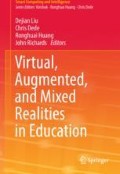Abstract
VR, AR, and MR are becoming ubiquitous in consumer gaming, military applications, and office environments. These successes are driving emerging efforts to integrate these immersive media into the K-12 classroom. In this chapter, first we summarize the distribution and availability of the infrastructure needed for using VR and MR in the schools. Using immersive media requires a technology infrastructure consisting of dependable high-speed Internet connectivity to the classroom, a ratio of at least one-to-one computer to student, an interactive white board, and curriculum materials that can be monitored and controlled by the teacher. This infrastructure is quickly becoming a reality. However, a larger and more complex barrier remains: integrating the new technologies with existing classroom systems and with existing and emerging pedagogical practice. I argue that the Digital Teaching Platform serves as a model for classroom practice. The evolving nature of digital curricula, formative assessment, and classroom practice impact how teachers will be able to integrate these new technologies. Finally, I examine how immersive media such as virtual reality, augmented reality, mixed reality, and multi-user virtual reality can work as supplemental digital materials for instruction and assessment. In particular, I focus on the sensory comfort and fidelity of interaction as these issues impact the viability of these technologies in the classroom.
Access this chapter
Tax calculation will be finalised at checkout
Purchases are for personal use only
Notes
- 1.
As mentioned in the Introduction, we use the term “immersive media” to refer to virtual reality, augmented reality, mixed reality, and MUVEs.
- 2.
We have restricted this analysis to the K-12 world. In higher education, as in the consumer market, there is ample bandwidth, students have multiple devices, and digital infrastructure is readily available in the learning environment Moreover, unlike K-12 education, higher education offers many interesting options for individual exploration and independent extension of the curriculum.
- 3.
This standard is somewhat subjective. 90 frames per second is acceptable, today.
References
comScore (2016). Cross-Platform future in focus, U.S. 2016. Downloaded May 27, 2016. http://www.comscore.com/Insights/Presentations-and-Whitepapers/2016/2016-US-Cross-Platform-Future-in-Focus.
Davis, S., Nesbitt, K., & Nalivaiko, E. (2014). A systematic review of cybersickness. In Proceedings of the 2014 Conference on Interactive Entertainment (pp. 8:1–8:9). New York: ACM. http://doi.org/10.1145/2677758.2677780.
Dede, C., & Richards, J. (Eds.). (2012). Digital teaching platforms: Customizing classroom learning for each student. New York: Teachers College Press.
Goff, N. Maylahn, P., Oates, B., & Oates, R. [MDR, 2015]. State of the K-12 market 2015, Part III: Educational technologies. Shelton, Connecticut: MDR.
IDC 2015. Smartphone Vendor Market Share. Downloaded, May 27, 2016. http://www.idc.com/prodserv/smartphone-market-share.jsp.
ITU 2014. Final WSIS targets review: Achievements, challenges and the way forward. International Telecommunication Union, Place des Nations, Geneva, Switzerland. Retrieved May 29, 2016. http://www.itu.int/en/ITU-D/Statistics/Pages/publications/wsistargets2014.aspx.
Kronqvist, A., Jokinen, J., & Rousi, R. (2016). Evaluating the authenticity of virtual environments. Advances in Human-Computer Interaction, 2016, 3.
Lawson, B. D. (2014). Motion sickness symptomatology and origins. In Handbook of virtual environments: Design, implementation, and applications (pp. 531–599). Boca Raton: CRC Press.
Oculus (2016) Best practices guide. https://static.oculus.com/documentation/pdfs/intro-vr/latest/bp.pdf.
Sinha, G. [BCC, 2016]. Virtual and augmented reality: Technologies and Global Markets. Wellesley, MA: BCC Research.
[2016]. Digest of Education Statistics U.S. Department of Education. Retrieved February 13, 2017.
Author information
Authors and Affiliations
Corresponding author
Editor information
Editors and Affiliations
Rights and permissions
Copyright information
© 2017 Springer Nature Singapore Pte Ltd.
About this chapter
Cite this chapter
Richards, J. (2017). Infrastructures for Immersive Media in the Classroom. In: Liu, D., Dede, C., Huang, R., Richards, J. (eds) Virtual, Augmented, and Mixed Realities in Education. Smart Computing and Intelligence. Springer, Singapore. https://doi.org/10.1007/978-981-10-5490-7_6
Download citation
DOI: https://doi.org/10.1007/978-981-10-5490-7_6
Published:
Publisher Name: Springer, Singapore
Print ISBN: 978-981-10-5489-1
Online ISBN: 978-981-10-5490-7
eBook Packages: Computer ScienceComputer Science (R0)

